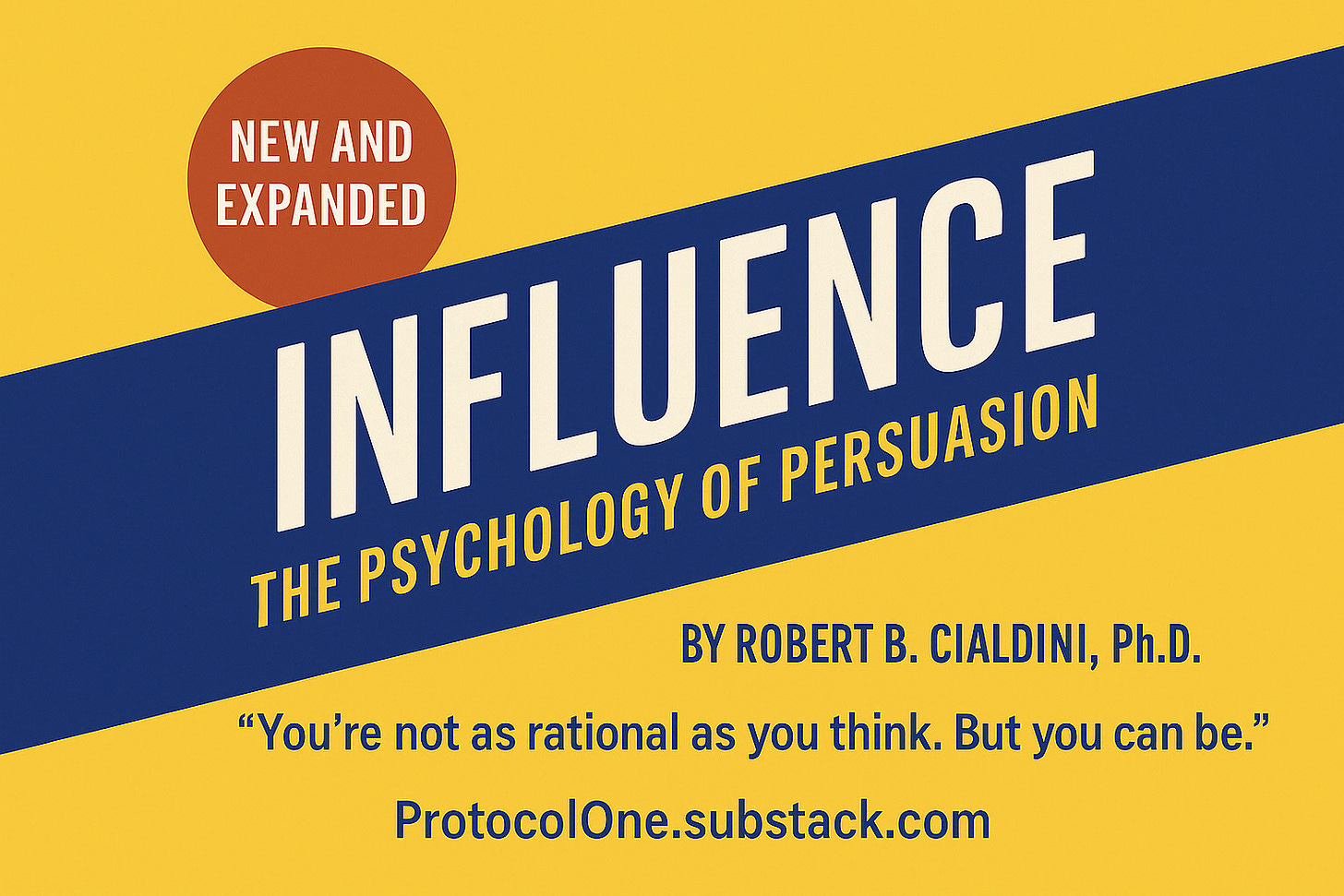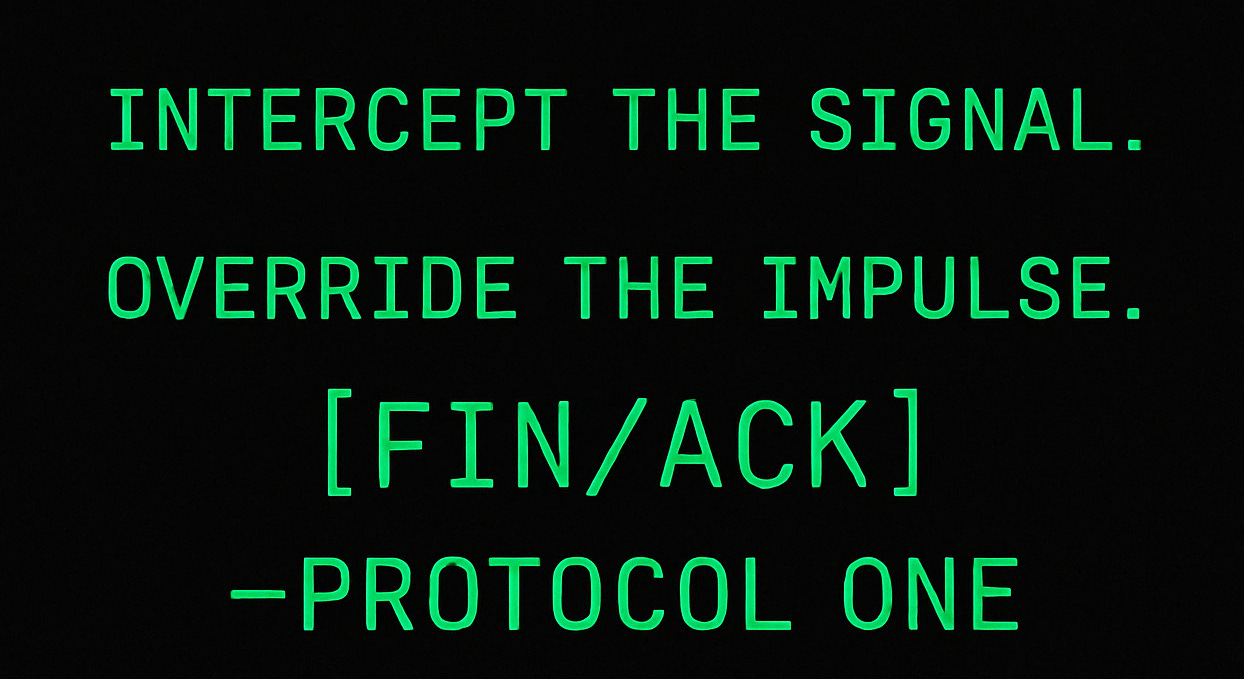Book Review: Influence by Robert Cialdini
You’re not as rational as you think. But you can be.
Strategic Briefing
Some books are weapons. This one is a countermeasure.
Influence doesn’t teach persuasion as a dark art—it reveals it as an operating system running quietly in the background of every human interaction. Robert Cialdini spent years embedded in high-influence environments—used car dealerships, telemarketing centers, fundraising drives—not to manipulate others, but to understand why people comply.
What he uncovered wasn’t trickery—it was predictability.
Human behavior runs on scripts. Influence shows you where they’re hidden.
The book distills persuasion into seven universal principles. These aren’t just sales tools. They’re the levers that move opinion, shape behavior, and make systems (and people) bend.
The 7 Principles of Persuasion (and Why They Matter)
Reciprocity — We’re wired to give back when something’s given. Even unsolicited “gifts” can compel a yes.
Commitment & Consistency — Once we commit, we work hard to stay aligned—even when it no longer makes sense.
Social Proof — When uncertain, we copy the crowd. Conformity feels like safety.
Authority — Titles, uniforms, credentials—these cues override skepticism faster than facts.
Liking — We say yes to people we like, or people who reflect us. Familiarity lowers resistance.
Scarcity — Limited access creates urgency. We chase what feels rare, not necessarily what’s valuable.
Unity — Shared identity breaks down resistance. We trust those who feel like part of “us.”
Each principle is backed by behavioral science and embedded in everyday life.
Ads use them. Politicians weaponize them. Children learn them instinctively.
The real question isn’t whether you’re being influenced.
It’s whether you recognize it—and whether you’re ready to resist.
What I Took With Me
I didn’t listen to this book to become more persuasive.
I listened to understand why people move—and why I do.
Now I can’t unhear it.
The signals are everywhere.
Scarcity. Charm. Expertise. Groupthink.
Persuasion hides in the rhythm of normal conversation.
It’s not subtle once you know what to watch and listen for.
Now I’m learning to tune in to a different frequency—
and learning what to question.
I haven’t applied this yet—but I will.
I’ll slow down. Watch for the patterns.
And start noticing the script behind the ask.
Because the real power isn’t in using these principles.
It’s in knowing when they’re being used on you.
CORTEX OPS: The Brain Science Behind the System
Understanding influence isn’t just about psychology—it’s about neuroarchitecture. These principles exploit deep, ancient circuits. Let’s decode.
1. Reciprocity
Codename: The Default Social Contract
Region: Prefrontal Cortex + Anterior Cingulate Cortex
Mechanism:
This circuit evolved to preserve fairness in close-knit groups. When someone gives you something—whether you wanted it or not—your brain flags an imbalance. The anterior cingulate fires up to track the “debt,” while your executive functions push for resolution through payback.
In the Wild:
Free samples
Surprise gifts
“No obligation” favors
TL;DR:
Your brain hates feeling in debt. Reciprocity hijacks this wiring.
Countermeasure:
Pause and ask: Did I want this? Or was it preloaded for compliance?
2. Commitment & Consistency
Codename: Identity Looping
Region: Dorsolateral Prefrontal Cortex + Basal Ganglia
Mechanism:
Your brain favors internal coherence. Once you state a belief or take a stand—especially publicly—the dlPFC tags it to your identity. Meanwhile, the basal ganglia automates it as a habit. Changing course now feels like self-betrayal.
In the Wild:
Signing petitions
Public affirmations
“You said yes before...”
TL;DR:
Once you say it or post it, you become it.
Countermeasure:
Don’t confuse past self with true self. Updating is not inconsistency—it’s intelligence.
3. Social Proof
Codename: Tribal Safety Protocol
Region: Posterior Cingulate + Mirror Neuron System
Mechanism:
From a survival standpoint, going with the group reduces danger. Your mirror neurons track what others are doing. The posterior cingulate makes it feel “right” to match them—even if it’s wrong.
In the Wild:
Product reviews
Applause cues
Viral content
TL;DR:
Monkey see = Monkey do. Because monkey survive.
Countermeasure:
High engagement ≠ high value. Break the loop and assess solo.
4. Authority
Codename: The Obedience Circuit
Region: Ventromedial Prefrontal Cortex
Mechanism:
This part of your brain evaluates risk and reward—but it often defers when it sees symbols of expertise: lab coats, credentials, titles. Delegation becomes obedience. Thinking is offloaded.
In the Wild:
“Experts agree”
Uniforms, degrees
Authoritative tone
TL;DR:
Trusting “the suit” is easier than thinking.
Countermeasure:
Ask what authority is based on: data or display? Respect doesn’t equal correctness.
5. Liking
Codename: Dopamine Alignment
Region: Nucleus Accumbens + Ventral Tegmental Area (VTA)
Mechanism:
We trust those we like—because our brain gives us dopamine for doing so. Familiarity, attractiveness, and flattery activate the reward system and lower defenses. The result? Yes becomes automatic.
In the Wild:
Compliments
“We’re just like you” vibes
Familiar spokespersons
TL;DR:
You say yes because it feels good—biochemically.
Countermeasure:
Separate the message from the messenger. Charisma ≠ credibility.
6. Scarcity
Codename: Risk of Loss Amplification
Region: Amygdala + Striatum
Mechanism:
The amygdala perceives limited access as a threat. The striatum responds with urgency and reward anticipation. Your emotional brain rushes to grab the opportunity—often before logic can weigh in.
In the Wild:
Countdown timers
“Only 2 seats left”
Limited edition drops
TL;DR:
Scarcity flips your system from logic to panic.
Countermeasure:
Ask: “Is this urgency real—or engineered?” Breathe before action.
7. Unity
Codename: Identity Fusion Protocol
Region: Medial Prefrontal Cortex + Default Mode Network
Mechanism:
When someone signals shared identity, your brain collapses the “other” barrier. The DMN activates your narrative sense of self and bonds it to the tribe. Trust follows. So does compliance.
In the Wild:
“We’re all in this together”
Flags, faith, fandoms
Shared enemy framing
TL;DR:
If they’re one of us, we drop our guard.
Countermeasure:
Belonging isn’t proof. Common ground can be camouflage.
These principles don’t work because people are stupid.
They work because the brain is efficient.
Your mind automates to survive. It runs scripts. Macros.
Fast decisions. Low friction. Minimum load.
Persuasion isn’t hacking intellect—it’s exploiting optimization.
Cialdini doesn’t shame the system.
He exposes it.
He hands you the debugger.
Shows you where the levers are.
You don’t need new software.
You need override access.
To pause the playback.
To break the loop.
To choose to respond—not react.
Training the Mind: Tactical Applications
1. Pause on urgency
Scarcity isn’t always fake, but it’s often designed.
Your amygdala reacts before reason comes online. Wait a beat.
2. Audit your defaults
Most “yes” responses aren’t agreement.
They’re avoidance—of awkwardness, of conflict, of thinking too hard.
Notice what you’re really saying yes to.
3. Frame with intention
Every ask relies on a principle.
Reciprocity, social proof, authority—choose the one you mean to use.
Influence starts before the question is asked.
4. Guard your identity triggers
Unity works through belonging.
It bypasses logic by making you feel seen.
When it feels tribal, step back and observe.
5. Train the prefrontal cortex
Reflection builds resistance.
Question your first impulse.
That’s how you go from subject to strategist.
Final Transmission
Influence is required reading for thinkers, strategists, leaders, and anyone tired of being unconsciously nudged.
It won’t make you immune.
But it will make you intentional.
It gives language to things you’ve felt.
Frameworks to things you’ve sensed.
And defenses for things you didn’t even realize were attacks.
The human mind is influence-ready by design.
This book helps you install the override switch.
Clear thinking is a tactical advantage.
This is how you train the operator inside.
[FIN/ACK]
Transmission Complete
Process Accordingly
—Protocol One
If you're ready to see the levers behind persuasion, grab the updated edition of Influence by Robert Cialdini here:
As an Amazon Associate, I earn from qualifying purchases.
No extra cost to you—Just fuel for the next transmission.








